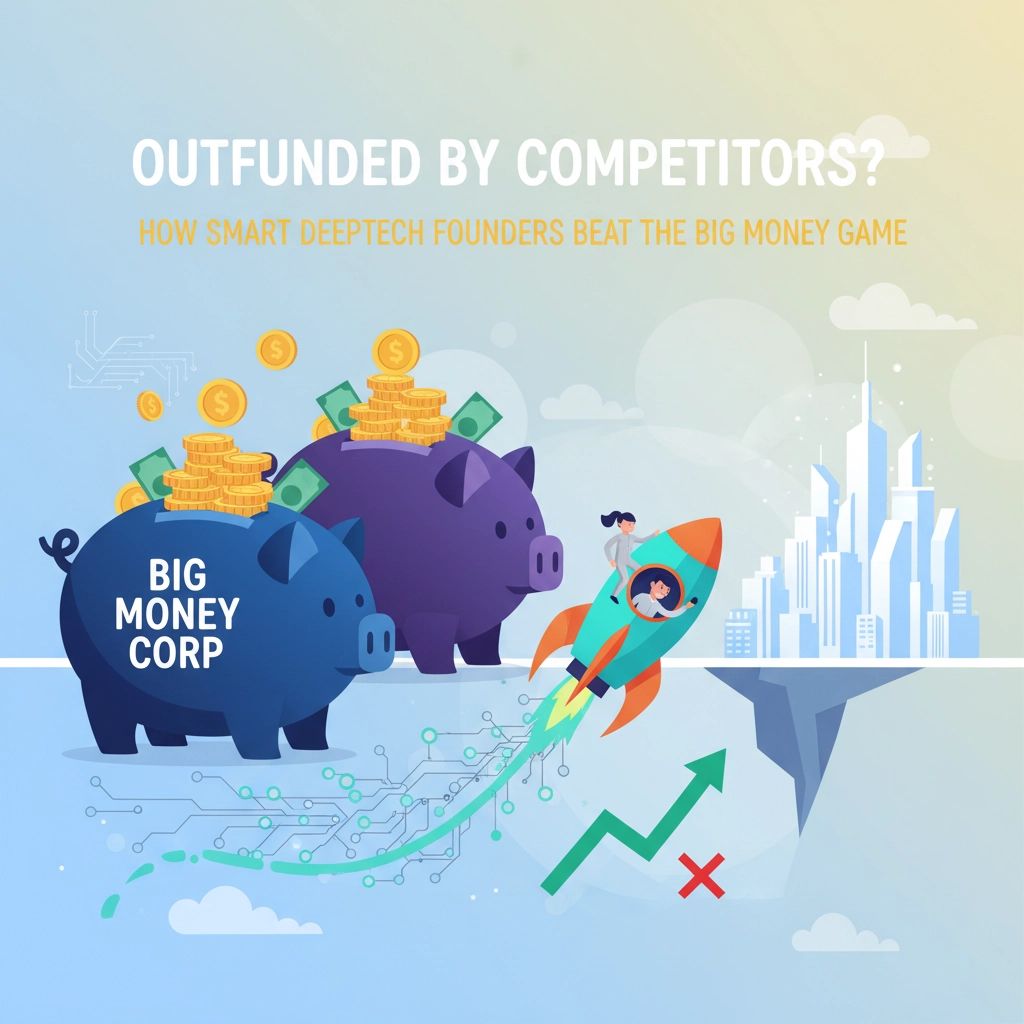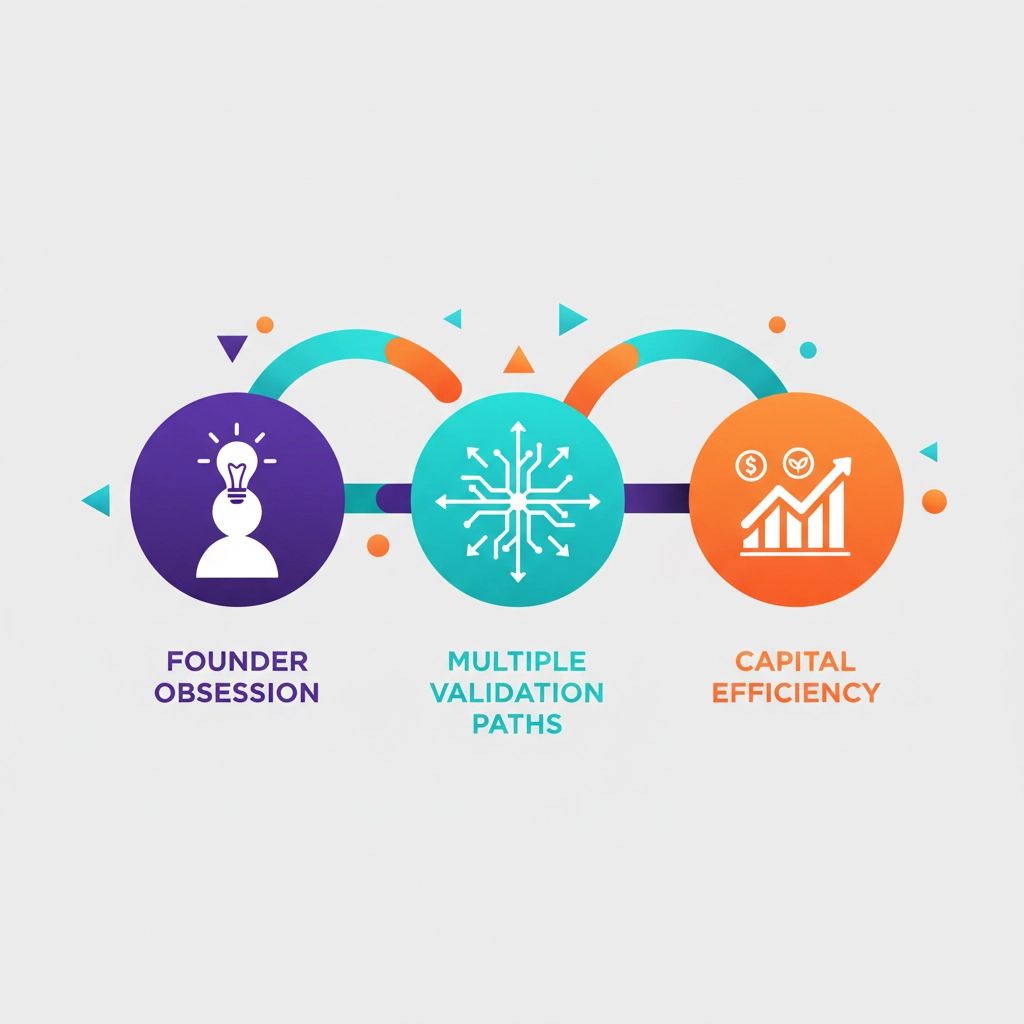Outfunded by Competitors? How Smart Deeptech Founders Beat the Big Money Game
Nov 05, 2025
You're watching competitors raise $50M+ rounds while you're bootstrapping on fumes. They're hiring entire engineering teams while you're coding at 2 AM. It stings, but here's the thing most founders miss: in deeptech and healthtech, being outfunded isn't a death sentence: it's often an advantage disguised as a disadvantage.
The founders who win this game aren't the ones with the biggest war chests. They're the ones who understand that deeptech competition runs on different rules entirely.
Why Your Competitors Are Getting All the Money (And Why It Doesn't Matter)
Let's be brutally honest about why some competitors seem to effortlessly raise massive rounds. They're often better at three things that have nothing to do with actual execution:
They're selling dreams, not milestones. VCs love big vision stories. A competitor promising to "revolutionize healthcare" sounds more exciting than your measured approach to solving one specific regulatory pathway problem. But here's what investors don't tell you: vision raises rounds, but execution builds companies.
They have insider networks. Some founders come from Stanford, worked at Google, or their dad knows a GP at Andreessen. Unfair? Absolutely. Game over? Not even close.
They're playing the traditional VC game. They're optimizing for the metrics that generalist VCs understand: TAM size, user growth, conventional business models. Meanwhile, you're solving actual scientific problems that take time to explain.

But here's the counter-intuitive truth: every advantage they have in fundraising becomes a disadvantage in execution. While they're managing investor updates and board meetings, you're obsessing over your technology. While they're hiring fast, you're hiring smart. While they're burning cash, you're proving concepts.
The Deeptech Advantage: Technical Credibility Beats Marketing Fluff
In consumer startups, the primary question investors ask is: "Will people want this?" In deeptech and healthtech, it's fundamentally different: "Will this actually work, and can this team make it work?"
This shifts the entire competitive landscape. Instead of competing on who can craft the most compelling pitch deck, you're competing on who can demonstrate the highest probability of technical success. And here's where being resource-constrained becomes your superpower.
Resource constraints force real validation. When Ginkgo Bioworks was burning $100M+ annually on their "platform approach," smaller biotech companies were quietly proving their individual drug candidates worked. Guess which approach led to more clinical trial successes?
Pressure creates focus. Well-funded competitors often pursue multiple directions simultaneously. You can't afford that luxury: so you pick the one path most likely to succeed and execute it flawlessly.
Scrappy teams move faster. While your competitor spends three months getting approval for a new hire, you've already pivoted, tested, and validated a new approach.
Strategy 1: Build Your Fundraising Around Probability of Success
Stop trying to convince investors your market is big enough. Start proving your technology is ready enough.
The most successful deeptech and healthtech founders structure every conversation around concrete milestones: "Here's where we are, here's what we need for [FDA approval/clinical trial completion/regulatory clearance], here's the specific gap, here's our probability of success, and here's exactly what could go wrong."
This approach works because it's measurable and objective. An investor can evaluate your progress toward Phase II clinical trials or CE marking approval. They can't easily evaluate whether your "AI-powered healthcare platform" will change the world.

For healthtech founders: Frame everything around regulatory pathways. "We're 18 months from 510(k) clearance, with three of five validation studies complete." This gives investors concrete timelines and risk assessment frameworks.
For deeptech founders: Focus on technical milestones that unlock commercial value. "Our algorithm achieves 94% accuracy on the benchmark dataset, with production deployment planned for Q3." Specific, measurable, achievable.
Strategy 2: Expand Your Fundraising Horizons Beyond Traditional VC
While your competitors fight over the same pool of traditional VCs, smart founders are tapping into entirely different capital sources.
High-net-worth individuals often have more patience than institutional VCs and deeper interest in mission-driven companies. A former pharmaceutical executive who sold their company understands your regulatory challenges better than a 28-year-old associate at a generalist fund.
Family offices represent massive capital pools that most founders never approach. They're relationship-oriented, often sector-focused, and willing to move quickly on opportunities they understand.
Strategic investors bring more than money: they bring distribution, regulatory expertise, and industry credibility. A partnership with Johnson & Johnson Innovation or Google Ventures validates your technology in ways that pure-play VCs cannot.
The key insight: there's substantial capital available outside traditional venture ecosystem, but only if you're willing to invest time in relationship building before you desperately need it.
Strategy 3: Choose Smart Money Over Big Money
Not all investors are created equal, especially in deeptech and healthtech. One sophisticated investor who understands your technology stack is worth ten generalists who see you as "yet another AI company."
Seek domain expertise over check size. An investor who previously built and sold a medical device company will provide operational insights that accelerate your FDA pathway. A former pharmaceutical executive understands clinical trial design in ways that benefit you far beyond their capital contribution.
Prioritize active involvement over passive capital. Talk to other portfolio companies. Does this investor just write checks, or do they roll up their sleeves during critical decisions? The difference is substantial when you're competing against better-funded teams.

Look for pattern recognition, not pattern matching. The best investors have seen multiple companies navigate similar challenges and can help you avoid common pitfalls. They've watched competitors succeed and fail, and they understand which strategies actually work versus which ones just sound good in board meetings.
Strategy 4: Solve Real Problems From Day One
The most successful deeptech and healthtech companies aren't pursuing R&D for its own sake: they focus on real-world applications and early customer validation from the beginning.
This early validation becomes your unfair advantage against well-funded competitors who might be building impressive technology that nobody actually needs.
For healthtech founders: Find your first clinical partner early. A single hospital system willing to pilot your solution validates product-market fit more convincingly than any investor presentation. It also provides real-world feedback that improves your technology faster than theoretical development.
For deeptech founders: Identify your anchor customer before you finish building. Whether it's a pharmaceutical company needing better drug discovery tools or a manufacturing company requiring process optimization, early customer relationships prove demand and provide development direction.
Early customers don't care about your funding level: they care about whether you solve their problem better than existing solutions.
Strategy 5: Maintain Founder Obsession and Capital Efficiency
Research consistently shows that founder-led companies with efficient capital management significantly outperform competitors, regardless of funding level. Three characteristics separate winners from the rest:
Founder obsession: You think about your product constantly, make rapid decisions, and maintain clear strategic vision. This enables faster iteration cycles than bureaucratic, well-funded competitors can achieve.
Multiple validation paths: Early evidence that your technology has platform potential, not just one application. This demonstrates broader impact potential and reduces risk perception for future investors.
Capital efficiency: Demonstrating progress toward revenue or clear monetization path before massive dilution. This extends runway and preserves founder control and focus.

For outfunded founders, these become operational advantages. You move faster because the founder is directly involved in every decision. You build multiple paths to value because you can't afford to be a one-trick pony. You're capital-efficient because you have to be.
Strategy 6: Leverage Networks to Build Syndication
You don't have to fundraise alone. The most successful outfunded founders find one excellent anchor investor who creates momentum for subsequent fundraising.
A credible lead investor validates your startup's potential in ways that even passionate pitches cannot. This is where quality of investor matters more than quantity of capital. One well-connected anchor investor opens doors to subsequent rounds more effectively than multiple mediocre investors.
Focus on investors who syndicate well. Some investors are excellent at bringing other high-quality investors into rounds. They have reputation and relationships that create FOMO among their peers.
Build relationships before you need them. The founders who start cultivating relationships with potential investors early: not during funding crises: have far better success rates.
The Counter-Intuitive Truth About Competition
Deep tech and healthtech competition isn't a capital competition: it's a technology, execution, and network competition. When you're outfunded, you win by playing to these sectors' actual success drivers: solving real problems, demonstrating technical progress, building relationships with smart capital, and maintaining the founder focus that larger organizations struggle to achieve.
Capital is a resource; execution and technical credibility are competitive advantages that money alone cannot buy.
Your well-funded competitors will spend months in meetings while you're in the lab. They'll optimize for investor metrics while you optimize for customer outcomes. They'll hire fast while you hire smart.
And when the market inevitably shifts, the regulatory landscape changes, or technical challenges emerge that require real expertise rather than just capital, you'll be the one still standing.
Ready to turn your resource constraints into competitive advantages? Join hundreds of deeptech and healthtech founders who are building sustainable, fundable companies without burning through massive war chests. Get access to the strategies and frameworks that help technical founders compete and win against better-funded competitors.